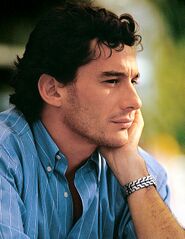Difference between revisions of "Ayrton Senna"
From Sega Retro
| Line 15: | Line 15: | ||
[[Tectoy]] initially pitched the idea of an Ayrton Senna-endorsed racing game to Sega of Japan, leveraging Sega's popularity in the region executive vice president Shoichiro Irimajiri personally knew Senna, having previously been an executive at Honda with its F1 division, the engine provider for Senna's team at McLaren, under his oversight. Ayrton would be heavily involved in the game's development, suggesting changes to the game's mechanics and designing two of the game's tracks. Senna also recorded voice segments commenting on each of the F1 tracks in the game; he refused to record a segment for the Circuit de Barcelona-Catalunya until he had raced on it the first time at the 1992 Spanish Grand Prix, his first time on the track. | [[Tectoy]] initially pitched the idea of an Ayrton Senna-endorsed racing game to Sega of Japan, leveraging Sega's popularity in the region executive vice president Shoichiro Irimajiri personally knew Senna, having previously been an executive at Honda with its F1 division, the engine provider for Senna's team at McLaren, under his oversight. Ayrton would be heavily involved in the game's development, suggesting changes to the game's mechanics and designing two of the game's tracks. Senna also recorded voice segments commenting on each of the F1 tracks in the game; he refused to record a segment for the Circuit de Barcelona-Catalunya until he had raced on it the first time at the 1992 Spanish Grand Prix, his first time on the track. | ||
| − | Sega would later publish ''[[Ayrton Senna Personal Talk: Message for the future]]'', a multimedia disc for the [[Sega Saturn]] comprising of English-language interviews with Senna overlaid with still images of the driver. Unlike ''Super Monaco GP II'' | + | Sega would later publish ''[[Ayrton Senna Personal Talk: Message for the future]]'', a multimedia disc for the [[Sega Saturn]] comprising of English-language interviews with Senna overlaid with still images of the driver. Unlike ''Super Monaco GP II'', ''Personal Talk'' was released exclusively in Japan. |
==Production history== | ==Production history== | ||
Revision as of 04:55, 8 June 2019

|
| Ayrton Senna |
|---|
| Place of birth: São Paulo, Brazil |
| Role(s): Supervisor |
| Education: Colegio Rio Branco |
This teeny-tiny article needs some work. You can help us by expanding it.
Ayrton Senna da Silva (Brazilian Portuguese: [aˈiʁtõ ˈsẽnɐ dɐ ˈsiwvɐ]; 21 March 1960 – 1 May 1994) was a Brazilian racing driver who won Formula One world championships for McLaren in 1988, 1990 and 1991, and who is widely regarded as one of the greatest Formula One drivers of all time. He died in an accident while leading the 1994 San Marino Grand Prix for Williams.
Association with Sega
During the early 90s Senna collaborated with Sega and provided technical input for Ayrton Senna's Super Monaco GP II.
Tectoy initially pitched the idea of an Ayrton Senna-endorsed racing game to Sega of Japan, leveraging Sega's popularity in the region executive vice president Shoichiro Irimajiri personally knew Senna, having previously been an executive at Honda with its F1 division, the engine provider for Senna's team at McLaren, under his oversight. Ayrton would be heavily involved in the game's development, suggesting changes to the game's mechanics and designing two of the game's tracks. Senna also recorded voice segments commenting on each of the F1 tracks in the game; he refused to record a segment for the Circuit de Barcelona-Catalunya until he had raced on it the first time at the 1992 Spanish Grand Prix, his first time on the track.
Sega would later publish Ayrton Senna Personal Talk: Message for the future, a multimedia disc for the Sega Saturn comprising of English-language interviews with Senna overlaid with still images of the driver. Unlike Super Monaco GP II, Personal Talk was released exclusively in Japan.
Production history
- Ayrton Senna's Super Monaco GP II (1992) — Supervisor
- Ayrton Senna Personal Talk: Message for the future (Saturn) (1995) — Posthumous appearance (archive footage)